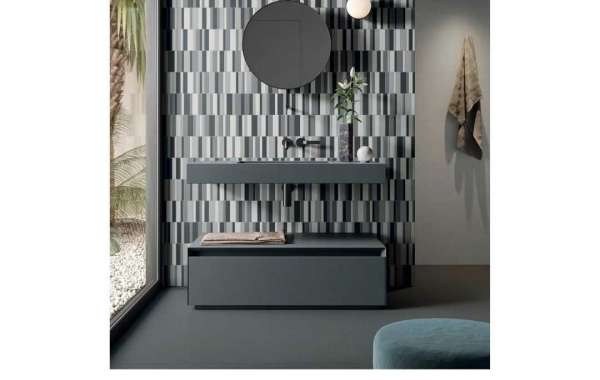Tiles are made from several different types of materials, depending on whether you want to tile your garden or home. Porcelain is a common material among them. In floor spaces, porcelain is typically used as a durable and strong material. Discover everything you need to know about porcelain tiles...
Why do porcelain tiles exist?
Ceramic porcelain is actually a type of ceramic, but it's far more durable and hard-wearing due to the materials it's made from and the temperatures at which it's fired.
Is there a secret ingredient? The most common composition of porcelain tiles is 50% Feldspar, 30%-40% white clay, up to 15% Kaolin, and up to 15% quartz. What is the result? With its superior durability and abrasion resistance, this tile can withstand harsh conditions. Water won't penetrate them either!
Do porcelain tiles have a place in my home?
Tiles made from porcelain come in a variety of shapes, sizes, styles and colours, so they can be used anywhere inside and outside the home. They are, however, quite suitable for flooring spaces with high footfall, wet rooms, bathrooms, and gardens due to some of their characteristics (high durability, frost proof, water resistance). The hallway is usually the first space that friends and family pass through, so it's a space where sturdy porcelain tiles are definitely needed.
Garden Spaces Can Benefit From Porcelain Tiles
Our minds turn to our gardens when summer rolls around, thinking about how to make the most of them. Our guests will appreciate the opportunity to enjoy the sun, a BBQ, and our company by creating an outdoor patio area. How should we choose a material?
For external seating, decking is no longer a great idea; the wood rapidly deteriorates and is extremely slippery. A very drab and lifeless option, concrete slabs, are another former patio favourite, which will limit the character of your garden.
TOP 10 PORCELAIN TILE DESIGNS
When it comes to creating a patio area in a garden, porcelain tiles are proving to be an excellent choice. Furthermore, they are extremely durable, and frostproof, making them practically water-resistant. Porcelain designs with anti-slip finishes provide a secure ground in your garden. You can choose from a variety of stylish wood and stone effect designs.
Indoor-outdoor spaces are becoming increasingly popular. To create a seamless transition from indoors to outdoors, the interior floor continues to the outdoor level at the same height.
Porcelain tile styles and designs
The first thing that comes to mind when you think of ceramic or porcelain tiles is probably the plain white squares that go on the walls of your bathroom or kitchen. It's time to move beyond those days when those were the only options!
Porcelain tiles can be made in all kinds of shapes, sizes, styles and designs, as well as in a multitude of colors thanks to advances in manufacturing and HD ink jet printing technologies. We have stunning geometric patterns, hexagons and mosaics, including realistic wood effects, lifelike stone effects, and captivating geometric patterns!
Porcelain tiles are no longer limited to the bathroom and kitchen because they cover all of the latest interior design trends. Instead of carpet, laminate, lino, hardwood, paint, and wallpaper, they're a viable alternative that lasts for years. Even outside on the patio or deck, they provide a beautiful alternative to decking and slabs!
How do I choose porcelain tiles?
While there is no doubt that there are a wealth of different design options to choose from, which would be most suitable for your home? Whatever look you're trying to achieve depends on where you're tiling.
This is a great trick for creating a soothing natural scheme in a room you feel like relaxing in, such as a bathroom or bedroom. A stone effect tile can be helpful in this situation. To achieve this naturalistic spa-like look, elegant marble effect tiles are a popular choice!
Injecting lots of colour or pattern is a great idea when tiling a sociable room such as a kitchen, dining room or living room. To create a feature wall, you can use our Hexa Cube 3D Tiles (which appeared recently in HomeStyle Magazine) or Zeinah Tiles (which appeared recently in Ideal Home Show room sets).
You want something in a hallway that isn't overpowering, but it's also not too plain, as it's often the first thing your guests will see. Our Swoonworthy Wood Effect Tiles are a great example of wood effect tiles that work well in these situations.
When it comes to designing an outdoor space, natural-styled designs are most effective. If you're looking to make those patio spaces a little bit more grippable, consider wood effect tiles with an anti slip finish. A garden area would benefit from vintage wood plank tiles.
Protecting polished porcelain with sealant
There is a difference in moisture resistance between polished and unpolished porcelain tiles. This causes them to stain when grout is applied. It is recommended that you seal the grout before and after grouting with LTP MPG Sealer to prevent this from happening. An application guide is provided here:
Clean and dry the surface, and if there is any underfloor heating, make sure it is working properly.
Using an LTP Buffing Cloth, apply the LTP MPG Sealer evenly to the surface.
Allow 20 minutes to pass. To remove an excess from the surface, buff the surface well. If you are still working with wet LTP MPG Sealer, do this.
Do not walk on the surface for at least three hours after the surface has dried.
For a minimum of three days, protect the surfaces from water for 24 hours.
Porcelain tile cleaning and care
You should avoid using steam cleaners, bleach, or other strong acidic / alkaline cleaners on polished porcelain tiles, since they can damage their seals.
You can use LTP Waxwash to clean and maintain porcelain tiles, whether polished or unpolished. It will keep your tiles looking as fresh and as new as the day you first installed them.
How to cut porcelain tiles
Naturally as part of any tiling job, you’ll probably come to a point where you need to cut some tiles. Mark the tile where it needs to be cut, and remember to allow for whatever thickness of grout joint you might use. Manual tile cutters can be used to cut thinner porcelain tiles, whereas wet cutters may be required for thicker tiles.
Line your marked line up with the scribing wheel if you are using a manual tile cutter. Scribing the tile can be done by pushing the scribing wheel across the surface. Apply gentle pressure with the snapping arm over the top of the tile once you've done this. Snapping the tile this way will result in a clean break.
Make sure you turn off the electric / wet cutter until you're ready to use it. The tile should be placed into the cutter with the blade width at the top. Put the tile in the machine and turn it on. With this, you will have a nice, clean cut. Our recommendation is to use wet cutters outdoors due to potential mess.
Porcelain tile installation and grouting
When applying porcelain tiles to a wall or floor, the process remains roughly the same, and can be broken down into three basic phases: plan the layout, apply the tiles with adhesive, and grout the joints.
A handy DIY How To Tile section has been added to our website, with step-by-step videos to guide you through tiling walls, floors, bathrooms, and kitchens. Visit our website and take a look!
A brief summary
That's all there is to know about porcelain tiles. In summary, they're an attractive offering of tiles that are durable, water-resistant and frost-proof, making them an excellent choice for floors, bathrooms, and gardens outdoors. Several styles are available, making them ideal for introducing different trends and looks throughout the house. By ordering samples, you can find out which ones work best in your home.










